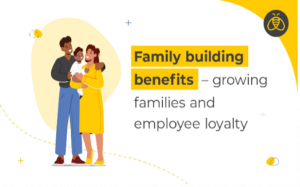 BACKGROUND
BACKGROUND
For many companies this time of year often means reviewing their benefits package – for both a cost and a coverage standpoint.
- Cost because benefits for 2025 are rising on average above 5% for the 3rd consecutive year, and represent a significant percentage of employee compensation costs.
- Coverage because more and more employees and potential employees are focusing on an employer’s benefits package in making their stay/leave and accept an employment offer or not.
Employers recognize that employees (and potential employees) place a high value on the benefits package, and, in particular, on health care benefits.
- So, despite rising health care rising cost costs, reports by nationally recognized health care experts show that employers are continuing to recognize family building benefits (and other family friendly ones) both as a differentiator from competitors for talent, and as a reflection of having a pro family culture.
- Various organizations (such as the National Infertility Association) are lobbying for infertility to be treated like any other disease with respect to coverage under health care benefits.
- 19 states have adopted legislation related to the issue of infertility
- In the two most recent U.S. Congresses legislation has been proposed.
NOTE: Both the American College of Obstetricians and Gynecologists and the American Society for Reproductive Medicine have determined that infertility is indeed a disease. I see parity for infertility to achieve parity with other medical conditions as this proceeding on the same course as mental health coverage successfully traveled 20 years ago.
WHAT ARE FERTILITY AND FAMILY BUILDING BENEFITS?
Family building benefits refer to the range of services and support employers provide to their employees to assist them in starting and growing their families.
They can include some or all of the following:
- Medical coverage: Access to fertility treatments, hormone treatments, and assisted reproductive technologies
- Financial support: Reimbursement for fertility treatments, adoption, and surrogacy
- Adoption and surrogacy resources: Assistance with adoption and surrogacy
- Educational resources: Access to educational resources
- Flexible work arrangements to accommodate family planning
- Resources for adoption or surrogacy
LOOKING FOR AN EASY PLACE TO START
- Paid Bereavement Leave: Revise your policy to cover a miscarriage.
WHAT’S IN IT FOR EMPLOYERS?
- ATTRACT AND RETAIN TOP TALENT
- 68% of people said they would switch jobs for better fertility benefits
- 56% of people say that their healthcare benefits are the biggest reason for staying at their job
- 46% of employees would forgo more pay for a more generous health benefits package
- LOWER EMPLOYER HEALTHCARE COSTS
- When employees pay for their own fertility treatments, it actually costs the employer more money.
- That’s because when employees are paying for treatments out of pocket, it leads to more high-risk pregnancies and expensive NICU stays.
- IMPROVE EMPLOYEE PERFORMANCE
- Employer sponsored treatments can lead to superior clinical outcomes which reduces emotional and physical strain on employees and means less time away from work
- 14% lower miscarriage rate
- 17% higher pregnancy rate per IVF embryo transfer
- 27% higher live birth rate
- 36% fewer egg retrievals performed per live birth
- The financial strain of paying out of pocket for fertility treatments has a direct impact on employee performance as they may:
- Take on a second job to afford treatments
- Go into debt to pay for treatments
- Seek substandard (and risky) alternative care such as:
- Traveling to Mexico or other foreign countries for lower cost IVF treatments
- Electing to forgo anesthesia for painful treatments to save money
- Ordering medications from overseas pharmacies, or worse, obtaining medications from strangers online
- Employer sponsored treatments can lead to superior clinical outcomes which reduces emotional and physical strain on employees and means less time away from work
LOOKING FOR MORE INFORMATION AND ANSWERS?
Here are some leading 3rd party providers of fertility and family building services
- Progyny: Partners with companies and organizations to offer fertility and family building benefits
- Maven Clinic: Offers comprehensive services starting with family planning
- Ovia Health: Offers a customizable benefit that supports employees from preconception to postpartum and beyond
- Carrot Fertility: Offers a fertility benefits program that includes interactions with midwives, doulas, and Carrot Experts
SOME STATISTICS
The International Foundation of Employee Benefit Plans has been tracking fertility and family-forming benefits over the past eight years. According to the Foundation’s Employee Benefits Survey: 2024 Report, 42% of U.S. organizations currently offer fertility benefits.
As the data below shows, organizations are increasing their fertility-related benefit offerings
| BENEFIT TYPE | 2024 | 2022 | 2020 | 2018 |
| Some Form of Fertility Benefits | 42% | 40% | 30% | N/A |
| Fertility Medications | 32% | 28% | 24% | 8% |
| In Vitro Fertilization | 32% | 30% | 24% | 13% |
| Genetic Testing to Determine Infertility Issue | 19% | 16% | 12% | N/A |
| Non-IVF Treatments | 19% | 17% | 11% | 6% |
| Egg Harvesting/Freezing Services | 16% | 14% | 10% | 2% |
Author: Salvatore LoDico, SPHR
The HR Godfather TM
CEO, Trinity HR Consulting, Inc
Trinity HR provides retained searches and a full range of other HR management consulting services and solutions. It serves a diverse client base — major corporations, SMBs, start-ups, small family businesses and nonprofits (including churches and schools) throughout the US.
To schedule a no cost, no obligation conversation about your needs and how our Team’s expertise can help you with this or another HR-related matter, email me at SalLoDico@TrinityHR.net or call me at 856.905.1762.
YOU HAVE HR QUESTIONS…TRINITY HAS ANSWERS!